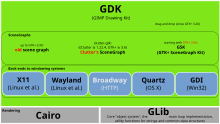A widget toolkit, widget library, GUI toolkit, or UX library is a library or a collection of libraries containing a set of graphical control elements used to construct the graphical user interface (GUI) of programs.
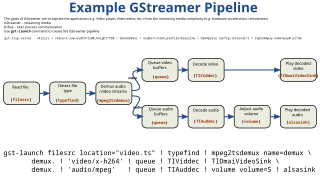
GStreamer is a pipeline-based multimedia framework that links together a wide variety of media processing systems to complete complex workflows. For instance, GStreamer can be used to build a system that reads files in one format, processes them, and exports them in another. The formats and processes can be changed in a plug and play fashion.

PyGTK is a set of Python wrappers for the GTK graphical user interface library. PyGTK is free software and licensed under the LGPL. It is analogous to PyQt/PySide and wxPython, the Python wrappers for Qt and wxWidgets, respectively. Its original author is GNOME developer James Henstridge. There are six people in the core development team, with various other people who have submitted patches and bug reports. PyGTK has been selected as the environment of choice for applications running on One Laptop Per Child systems.
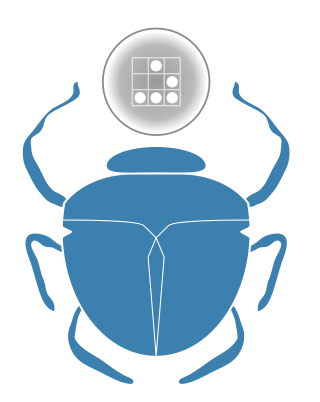
Cairo is an open-source graphics library that provides a vector graphics-based, device-independent API for software developers. It provides primitives for two-dimensional drawing across a number of different backends. Cairo uses hardware acceleration when available.
GNOME-DB is a database application by the GNOME community. The project aims to provide a free unified data access architecture to the GNOME project for all Unix platforms. GNOME-DB is useful for any application that accesses persistent data, since it contains a data management API.

The GLib Object System, or GObject, is a free software library providing a portable object system and transparent cross-language interoperability. GObject is designed for use both directly in C programs to provide object-oriented C-based APIs and through bindings to other languages to provide transparent cross-language interoperability, e.g. PyGObject.

GLib is a bundle of three low-level system libraries written in C and developed mainly by GNOME. GLib's code was separated from GTK, so it can be used by software other than GNOME and has been developed in parallel ever since.

GDK is a library that acts as a wrapper around the low-level functions provided by the underlying windowing and graphics systems. GDK lies between the display server and the GTK library, handling basic rendering such as drawing primitives, raster graphics (bitmaps), cursors, fonts, as well as window events and drag-and-drop functionality.
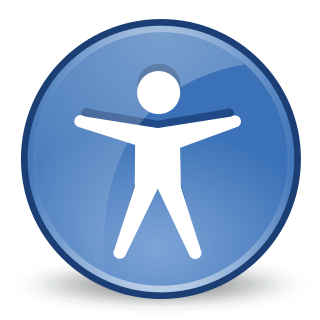
Accessibility Toolkit (ATK) is an open source software library, part of the GNOME project, which provides application programming interfaces (APIs) for implementing accessibility support in software.
A graphics library or graphics API is a program library designed to aid in rendering computer graphics to a monitor. This typically involves providing optimized versions of functions that handle common rendering tasks. This can be done purely in software and running on the CPU, common in embedded systems, or being hardware accelerated by a GPU, more common in PCs. By employing these functions, a program can assemble an image to be output to a monitor. This relieves the programmer of the task of creating and optimizing these functions, and allows them to focus on building the graphics program. Graphics libraries are mainly used in video games and simulations.
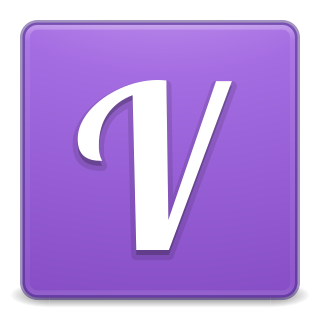
Vala is an object-oriented programming language with a self-hosting compiler that generates C code and uses the GObject system.
java-gnome is a set of language bindings for the Java programming language for use in the GNOME desktop environment. It is part of the official GNOME language bindings suite and provides a set of libraries allowing developers to write computer programs for GNOME using the Java programming language and the GTK cross-platform widget toolkit.

GTK is a free software cross-platform widget toolkit for creating graphical user interfaces (GUIs). It is licensed under the terms of the GNU Lesser General Public License, allowing both free and proprietary software to use it. It is one of the most popular toolkits for the Wayland and X11 windowing systems.
Seed is a JavaScript interpreter and a library of the GNOME project to create standalone applications in JavaScript. It uses the JavaScript engine JavaScriptCore of the WebKit project. It is possible to easily create modules in C.

mpv is free and open-source media player software based on MPlayer, mplayer2 and FFmpeg. It runs on several operating systems, including Unix-like operating systems and Microsoft Windows, along with having an Android port called mpv-android. It is cross-platform, running on ARM, PowerPC, x86/IA-32, x86-64, and MIPS architecture.
In computer science and visualization, a canvas is a container that holds various drawing elements. It takes its name from the canvas used in visual arts. It is sometimes called a scene graph because it arranges the logical representation of a user interface or graphical scene. Some implementations also define the spatial representation and allow the user to interact with the elements via a graphical user interface.

GTK Scene Graph Kit (GSK) is the rendering and scene graph API for GTK introduced with version 3.90. GSK lies between the graphical control elements (widgets) and the rendering.
